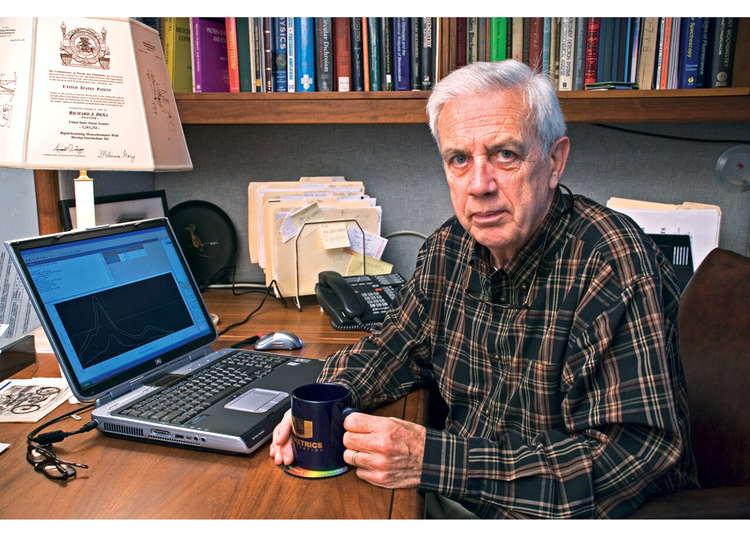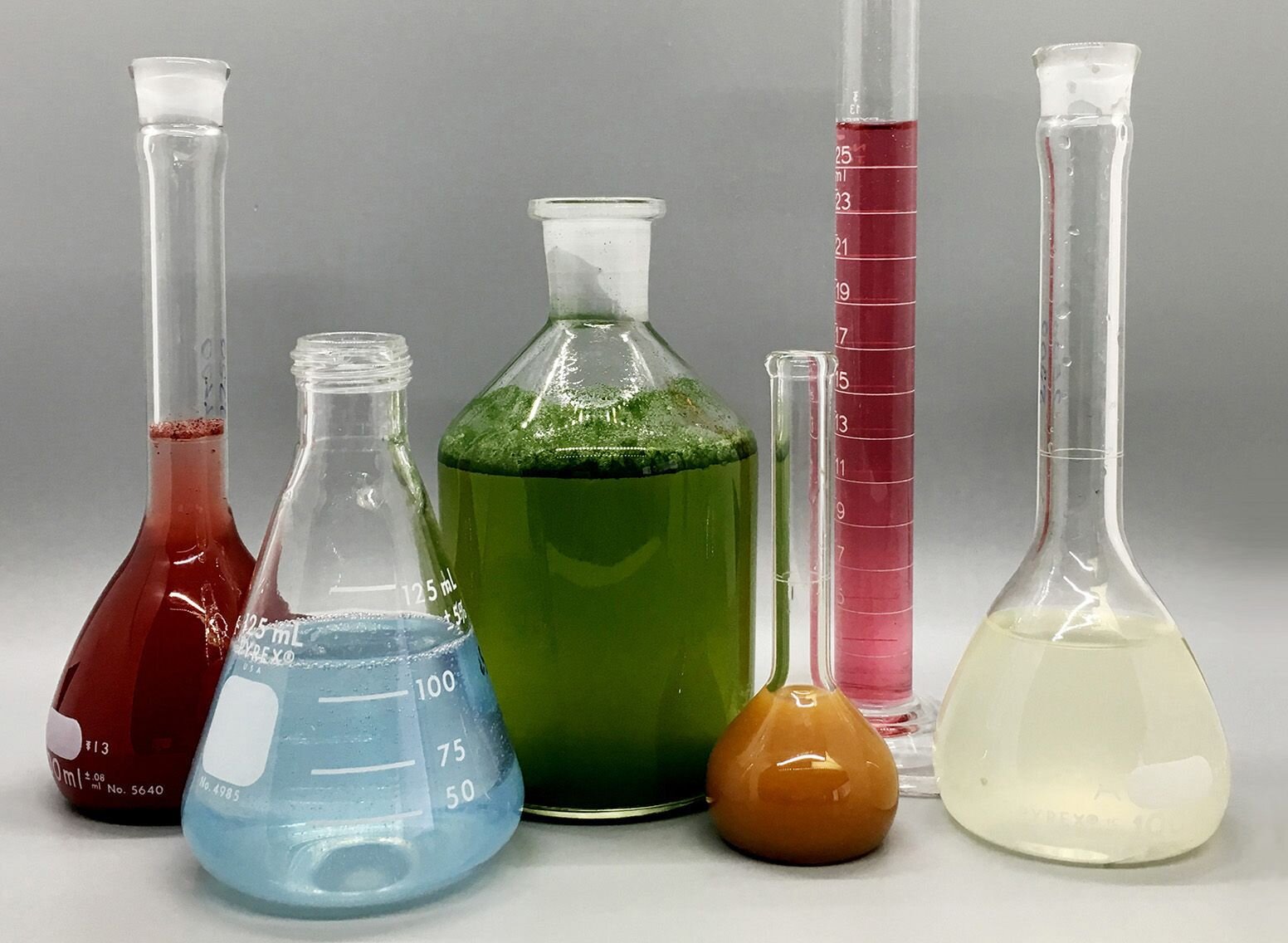The Of Circularly Polarized Luminescence
The Of Circularly Polarized Luminescence
Blog Article
Spectrophotometers Things To Know Before You Get This
Table of ContentsGetting My Uv/vis To WorkSome Known Incorrect Statements About Uv/vis/nir Some Ideas on Spectrophotometers You Should KnowThe Basic Principles Of Uv/vis/nir Some Of Circularly Polarized LuminescenceThe Buzz on Circular DichroismThe 10-Minute Rule for Uv/visExamine This Report about Circular DichroismAn Unbiased View of Uv/vis/nirFascination About Uv/vis/nirSee This Report about Uv/visWhat Does Circularly Polarized Luminescence Do?Our Circularly Polarized Luminescence Ideas
It is then scanned through the sample and the reference options. Fractions of the incident wavelengths are sent through, or reflected from, the sample and the recommendation. Electronic circuits convert the relative currents into direct transmission portions and/or absorbance/concentration values.The transmission of a recommendation compound is set as a standard (information) worth, so the transmission of all other substances are tape-recorded relative to the preliminary "zeroed" substance. The spectrophotometer then converts the transmission ratio into 'absorbency', the concentration of particular elements of the test sample relative to the initial compound.
Because samples in these applications are not readily offered in big quantities, they are specifically fit to being evaluated in this non-destructive method. In addition, precious sample can be saved by making use of a micro-volume platform where as little as 1u, L of sample is required for total analyses. A short explanation of the treatment of spectrophotometry includes comparing the absorbency of a blank sample that does not contain a colored compound to a sample that consists of a colored substance.
The Basic Principles Of Circular Dichroism
In biochemical experiments, a chemical and/or physical property is selected and the treatment that is utilized is specific to that home in order to obtain more information about the sample, such as the quantity, pureness, enzyme activity, etc. Spectrophotometry can be used for a variety of methods such as figuring out ideal wavelength absorbance of samples, identifying ideal p, H for absorbance of samples, figuring out concentrations of unknown samples, and determining the p, Ka of various samples.: 21119 Spectrophotometry is likewise a valuable procedure for protein filtration and can likewise be used as an approach to produce optical assays of a compound.
It is possible to know the concentrations of a two part mix using the absorption spectra of the standard solutions of each part. To do this, it is essential to know the extinction coefficient of this mix at two wave lengths and the termination coefficients of services which contain the recognized weights of the two components.

Circularly Polarized Luminescence - An Overview
Area. The concentration of a protein can be estimated by measuring the OD at 280 nm due to the existence of tryptophan, tyrosine and phenylalanine.
Nucleic acid contamination can also interfere. This technique needs a spectrophotometer capable of determining in the UV area with quartz cuvettes.: 135 Ultraviolet-visible (UV-vis) spectroscopy includes energy levels that thrill electronic shifts. Absorption of UV-vis light thrills molecules that remain in ground-states to their excited-states. Visible area 400700 nm spectrophotometry is utilized extensively in colorimetry science.
These curves can be utilized to check a brand-new batch of colorant to examine if it makes a match to requirements, e
Traditional visible standard spectrophotometers can not detect if find colorant or the base material has fluorescence. This can make it hard to manage color issues if for example one or more of the printing inks is fluorescent. There are 2 significant setups for visual spectrum spectrophotometers, d/8 (spherical) and 0/45.
Scientists utilize this instrument to measure the quantity of compounds in a sample. In the case of printing measurements 2 alternative settings are typically utilized- without/with uv filter to manage much better the result of uv brighteners within the paper stock.
Not known Facts About Circular Dichroism
Some applications need small volume measurements which can be carried out with micro-volume platforms. As described in the applications area, spectrophotometry can be utilized in both qualitative and quantitative analysis of DNA, RNA, and proteins. Qualitative analysis can be utilized and spectrophotometers are used to tape spectra of compounds by scanning broad wavelength regions to identify the absorbance homes (the strength of the color) of the compound at each wavelength.

The 7-Minute Rule for Circular Dichroism
One significant aspect is the kind of photosensors that are offered for various spectral regions, but infrared measurement is also challenging due to the fact that essentially everything discharges IR as thermal radiation, specifically at wavelengths beyond about 5 m. Another complication is that rather a few products such as glass and plastic take in infrared, making it incompatible as an optical medium.
Samples for IR spectrophotometry might be smeared between two discs of potassium bromide or ground with potassium bromide and pushed into a pellet. Where liquid services are to be determined, insoluble silver chloride is utilized to build the cell. Spectroradiometers, which operate almost like the noticeable region spectrophotometers, are designed to measure the spectral density of illuminants. Retrieved Dec 23, 2018. Fundamental Lab Methods for Biochemistry and Biotechnology (2nd ed.). The essential guide to analytical chemistry.
Chichester, NY: Wiley. pp. 1617. ISBN 9780471974123. OCLC 36543293. Ninfa AJ, Ballou DP (2004 ). Fundamental laboratory methods for biochemistry and biotechnology. Hoboken: Wiley. p. 66. ISBN 9781891786006. OCLC 633862582. Rendina G (1976 ). Philadelphia, PA: W. B. Saunders Company. pp. 46-55. ISBN 0721675506. OCLC 147990. Oke, J. B.; Gunn, J. E.
The Ultimate Guide To Spectrophotometers
"Secondary standard stars for absolute spectrophotometry". The Astrophysical Journal. 266: 713. Bibcode:1983 Ap, J..266..713 O. doi:10. 1086/160817. Ishani, G (2006 ). "The first business UV-vis spectrophotometer". p. 100. Obtained Dec 23, 2018. Simoni, RD; Hill, RL; Vaughan, M; Tabor, H (Dec 5, 2003). "A Classic Instrument: The Beckman DU Spectrophotometer and Its Developer, Arnold O.
278 (49 ): e1. doi:. ISSN 1083-351X. Beckman, A. O.; Gallaway, W. S.; Kaye, W.; Ulrich, W. F. (March 1977). "History of spectrophotometry at Beckman Instruments, Inc". Analytical Chemistry. 49 (3 ): 280A300A. doi:10. 1021/ac50011a001. "Hewlett Packard: Substance Identification with HP 8450 A UV Visible Spectrophotometer". Analytical Chemistry. 51 (12 ): 1188A1189A. 1979-10-01.
1021/ac50048a728. ISSN0003-2700. Ninfa AJ, Ballou DP, Benore M (2015 ). Fundamental Lab Approaches for Biochemistry and Biotechnology (3, rev. ed.). Hoboken, NJ: Wiley & Sons. p. 77. ISBN9780470924525. OCLC915641828. "Totally Automatic Double Beam - Atomic Absorption Spectrophotometer (AA 8000)". Lab Devices. Labindia Analytical Instruments Pvt. Ltd. "Spectrophotometry Applications and Basics".
Unknown Facts About Spectrophotometers
Retrieved Jul 4, 2018. Trumbo, Toni A.; Schultz, Emeric; Borland, Michael G.; Pugh, Michael Eugene (April 27, 2013). "Applied Spectrophotometry: Analysis of a Biochemical Mixture". Biochemistry and Molecular Biology Education. 41 (4 ): 24250. doi:10. 1002/bmb. 20694. PMID 23625877. (PDF). www. mt.com. Mettler-Toledo AG, Analytical. 2016. Retrieved Dec 23, 2018. Cortez, C.; Szepaniuk, A.; Gomes da Silva, L.
"Exploring Proteins Filtration Methods Animations as Tools for the Biochemistry Teaching". Journal of Biochemistry Education. 8 (2 ): 12. doi:. Garrett RH, Grisham CM (2013 ). Biochemistry. Belmont, CA: Cengage. p. 106. ISBN 978-1133106296. OCLC 801650341. Vacation, Ensor Roslyn (May 27, 1936). "Spectrophotometry of proteins". Biochemical Journal. 30 (10 ): 17951803. doi:10. 1042/bj0301795.
PMID 16746224. Hermannsson, Ptur G.; Vannahme, Christoph; Smith, Cameron L. C.; Srensen, Kristian T.; Kristensen, Anders (2015 ). "Refractive index dispersion noticing using a range of photonic crystal resonant reflectors". Applied Physics Letters. 107 (6 ): 061101. Bibcode:2015 Ap, Ph, L. 107f1101H. doi:10. 1063/1. 4928548. S2CID 62897708. Mavrodineanu R, Schultz JI, Menis O, eds.
Some Ideas on Uv/vis/nir You Should Know
U.S. Department of Commerce National Bureau of Standards unique publication; 378. Washington, D.C.: U.S. National Bureau of Standards.
The process begins with a regulated light that brightens the analyzed sample. In the case of reflection, as this light engages with the sample, some is absorbed or produced. The released light travels to the detector, which is analyzed, quantified, and provided as industry-standard color scales and indices.
All terms are assessed over the noticeable spectrum from 400 to 700 nm. In the case of transmission, when the light connects with the sample, it is either soaked up, shown, or sent.
Uv/vis Fundamentals Explained
Examples include APHA (American Public Health Association) for watercolor and purity analysis, ASTM D1500 redirected here for petrochemical color analysis, edible oil indices utilized in food, and color analyses of beverages. All terms are assessed over the visible spectrum from 400 to 700 nm.
Image Credit: Matej Kastelic/ Dr. Arnold J. Beckman and his colleagues at the National Technologies Laboratories first created the spectrophotometer in 1940. In 1935 Beckman founded the company, and the discovery of the spectrophotometer was their most ground-breaking innovation. Dr. Bruce Merrifield, a Nobel prize-winning biochemist, specified that the development of the spectrophotometer was "most likely the most important instrument ever developed towards the development of bioscience." Before the discovery of the spectrophotometer, chemical analyses took weeks to finish, with 25% accuracy.
A Biased View of Circularly Polarized Luminescence
99% accuracy. Over time, scientists kept improving the spectrophotometer design to boost its performance. The UV abilities of the design B spectrophotometer were improved by changing the glass prism with a quartz prism. Ultimately, the Model DU was produced, consisting of a hydrogen lamp and other enhancements. This instrument was used in commercial laboratories, centers, and chemistry and biochemistry departments.
After 1984, double-beam variations of the device were designed. The addition of external software application with the arrangement of onscreen display screens of the spectra was available in the 1990s. Typically, a spectrophotometer is comprised of 2 instruments, particularly, a spectrometer and a photometer. A standard spectrophotometer includes a light source, a monochromator, a collimator for straight beam transmission, a cuvette to position a sample, and a photoelectric detector.
Excitement About Uv/vis/nir
There are different types of spectrophotometers in different sizes and shapes, each with its own purpose or functionality. A spectrophotometer identifies just how much light is shown by chemical components. spectrophotometers. It measures the difference in light strength based upon the overall quantity of light introduced to a sample and the amount of light beam that passes through the sample option
A spectrophotometer is used to identify the concentration of both colorless and colored solutes in an option. This instrument is utilized to determine the rate of a response.
Report this page